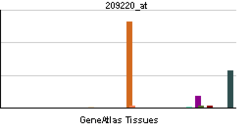Glypican 3
| View/Edit Human | View/Edit Mouse |
Glypican-3 is a protein that in humans is encoded by the GPC3 gene.[3][4][5][6] The protein encoded by this gene is a member of the glypican family.
Structure and function
Cell surface heparan sulfate proteoglycans are composed of a membrane-associated protein core substituted with a variable number of heparan sulfate chains. Members of the glypican-related integral membrane proteoglycan family (GRIPS) contain a core protein anchored to the cytoplasmic membrane via a glycosyl phosphatidylinositol linkage. These proteins may play a role in the control of cell division and growth regulation.[5]
Disease linkage
Deletion mutations in this gene are associated with Simpson-Golabi-Behmel syndrome.[7]
Diagnostic utility
Glypican 3 immunostaining has utility for differentiating hepatocellular carcinoma (HCC) and dysplastic changes in cirrhotic livers; HCC stains with glypican 3, while liver with dysplastic changes and/or cirrhotic changes does not.[8]
See also
References
- ↑ "Human PubMed Reference:".
- ↑ "Mouse PubMed Reference:".
- ↑ Pilia G, Hughes-Benzie RM, MacKenzie A, Baybayan P, Chen EY, Huber R, Neri G, Cao A, Forabosco A, Schlessinger D (Mar 1996). "Mutations in GPC3, a glypican gene, cause the Simpson-Golabi-Behmel overgrowth syndrome". Nat Genet. 12 (3): 241–7. doi:10.1038/ng0396-241. PMID 8589713.
- ↑ Veugelers M, Vermeesch J, Watanabe K, Yamaguchi Y, Marynen P, David G (Dec 1998). "GPC4, the gene for human K-glypican, flanks GPC3 on xq26: deletion of the GPC3-GPC4 gene cluster in one family with Simpson-Golabi-Behmel syndrome". Genomics. 53 (1): 1–11. doi:10.1006/geno.1998.5465. PMID 9787072.
- 1 2 "Entrez Gene: GPC3 glypican 3".
- ↑ Jakubovic BD, Jothy S (April 2007). "Glypican-3: from the mutations of Simpson-Golabi-Behmel genetic syndrome to a tumor marker for hepatocellular carcinoma". Exp. Mol. Pathol. 82 (2): 184–9. doi:10.1016/j.yexmp.2006.10.010. PMID 17258707.
- ↑ Davoodi J, Kelly J, Gendron NH, MacKenzie AE (June 2007). "The Simpson-Golabi-Behmel syndrome causative glypican-3, binds to and inhibits the dipeptidyl peptidase activity of CD26". Proteomics. 7 (13): 2300–10. doi:10.1002/pmic.200600654. PMID 17549790.
- ↑ Anatelli F, Chuang ST, Yang XJ, Wang HL (2008). "Value of glypican 3 immunostaining in the diagnosis of hepatocellular carcinoma on needle biopsy". Am J Clin Pathol. 130 (2): 219–23–8. doi:10.1309/WMB5PX57Y4P8QCTY. PMID 18628090.
External links
Further reading
- Li M, Squire JA, Weksberg R (1998). "Overgrowth syndromes and genomic imprinting: from mouse to man.". Clin. Genet. 53 (3): 165–70. doi:10.1111/j.1399-0004.1998.tb02668.x. PMID 9630066.
- Filmus J (2001). "Glypicans in growth control and cancer.". Glycobiology. 11 (3): 19R–23R. doi:10.1093/glycob/11.3.19R. PMID 11320054.
- Filmus J, Shi W, Wong ZM, Wong MJ (1995). "Identification of a new membrane-bound heparan sulphate proteoglycan". Biochem. J. 311 (Pt 2): 561–5. PMC 1136036
 . PMID 7487896.
. PMID 7487896. - Watanabe K, Yamada H, Yamaguchi Y (1995). "K-glypican: a novel GPI-anchored heparan sulfate proteoglycan that is highly expressed in developing brain and kidney". J. Cell Biol. 130 (5): 1207–18. doi:10.1083/jcb.130.5.1207. PMC 2120559
 . PMID 7657705.
. PMID 7657705. - Xuan JY, Besner A, Ireland M, et al. (1994). "Mapping of Simpson-Golabi-Behmel syndrome to Xq25-q27". Hum. Mol. Genet. 3 (1): 133–7. doi:10.1093/hmg/3.1.133. PMID 7909248.
- Maruyama K, Sugano S (1994). "Oligo-capping: a simple method to replace the cap structure of eukaryotic mRNAs with oligoribonucleotides". Gene. 138 (1–2): 171–4. doi:10.1016/0378-1119(94)90802-8. PMID 8125298.
- Shen T, Sonoda G, Hamid J, et al. (1997). "Mapping of the Simpson-Golabi-Behmel overgrowth syndrome gene (GPC3) to chromosome X in human and rat by fluorescence in situ hybridization". Mamm. Genome. 8 (1): 72. doi:10.1007/s003359900357. PMID 9021160.
- Lage H, Dietel M (1997). "Cloning and characterization of human cDNAs encoding a protein with high homology to rat intestinal development protein OCI-5". Gene. 188 (2): 151–6. doi:10.1016/S0378-1119(96)00689-0. PMID 9133586.
- Huber R, Crisponi L, Mazzarella R, et al. (1997). "Analysis of exon/intron structure and 400 kb of genomic sequence surrounding the 5'-promoter and 3'-terminal ends of the human glypican 3 (GPC3) gene". Genomics. 45 (1): 48–58. doi:10.1006/geno.1997.4916. PMID 9339360.
- Hsu HC, Cheng W, Lai PL (1997). "Cloning and expression of a developmentally regulated transcript MXR7 in hepatocellular carcinoma: biological significance and temporospatial distribution". Cancer Res. 57 (22): 5179–84. PMID 9371521.
- Suzuki Y, Yoshitomo-Nakagawa K, Maruyama K, et al. (1997). "Construction and characterization of a full length-enriched and a 5'-end-enriched cDNA library". Gene. 200 (1–2): 149–56. doi:10.1016/S0378-1119(97)00411-3. PMID 9373149.
- Pellegrini M, Pilia G, Pantano S, et al. (1999). "Gpc3 expression correlates with the phenotype of the Simpson-Golabi-Behmel syndrome". Dev. Dyn. 213 (4): 431–9. doi:10.1002/(SICI)1097-0177(199812)213:4<431::AID-AJA8>3.0.CO;2-7. PMID 9853964.
- Huber R, Mazzarella R, Chen CN, et al. (1999). "Glypican 3 and glypican 4 are juxtaposed in Xq26.1". Gene. 225 (1–2): 9–16. doi:10.1016/S0378-1119(98)00549-6. PMID 9931407.
- Xuan JY, Hughes-Benzie RM, MacKenzie AE (1999). "A small interstitial deletion in the GPC3 gene causes Simpson-Golabi-Behmel syndrome in a Dutch-Canadian family". J. Med. Genet. 36 (1): 57–8. doi:10.1136/jmg.36.1.57. PMC 1762951
 . PMID 9950367.
. PMID 9950367. - Veugelers M, Cat BD, Muyldermans SY, et al. (2000). "Mutational analysis of the GPC3/GPC4 glypican gene cluster on Xq26 in patients with Simpson-Golabi-Behmel syndrome: identification of loss-of-function mutations in the GPC3 gene". Hum. Mol. Genet. 9 (9): 1321–8. doi:10.1093/hmg/9.9.1321. PMID 10814714.
- Khan S, Blackburn M, Mao DL, et al. (2001). "Glypican-3 (GPC3) expression in human placenta: localization to the differentiated syncytiotrophoblast". Histol. Histopathol. 16 (1): 71–8. PMID 11193214.
